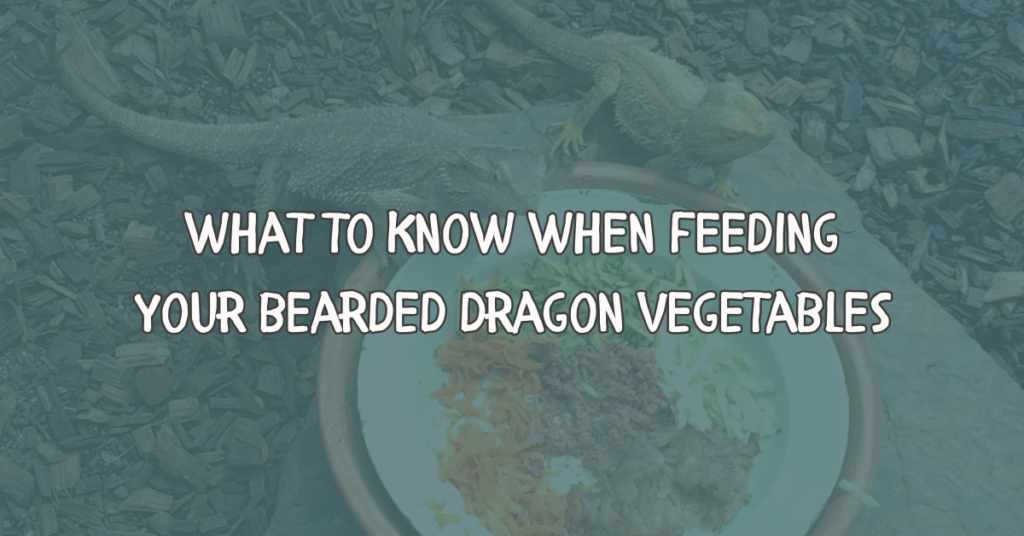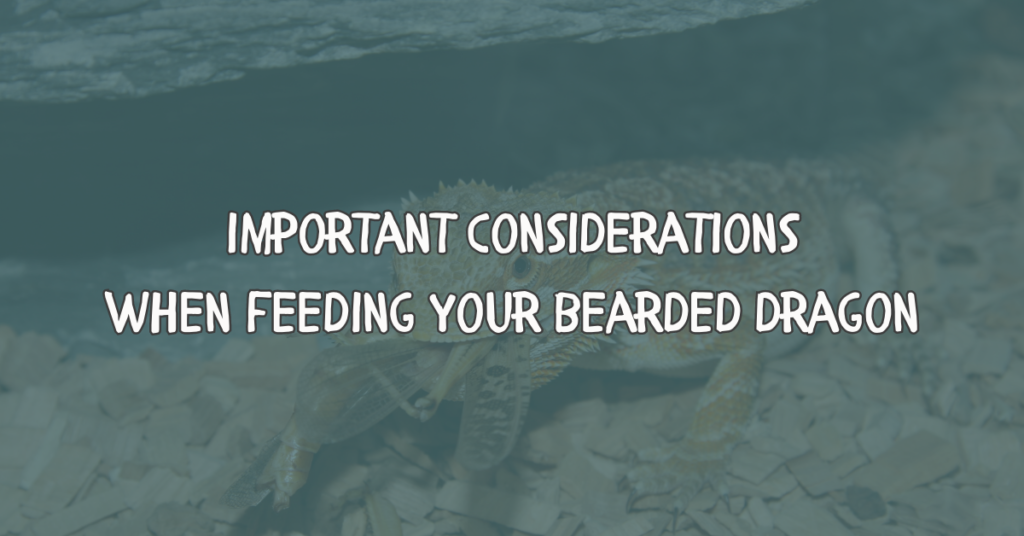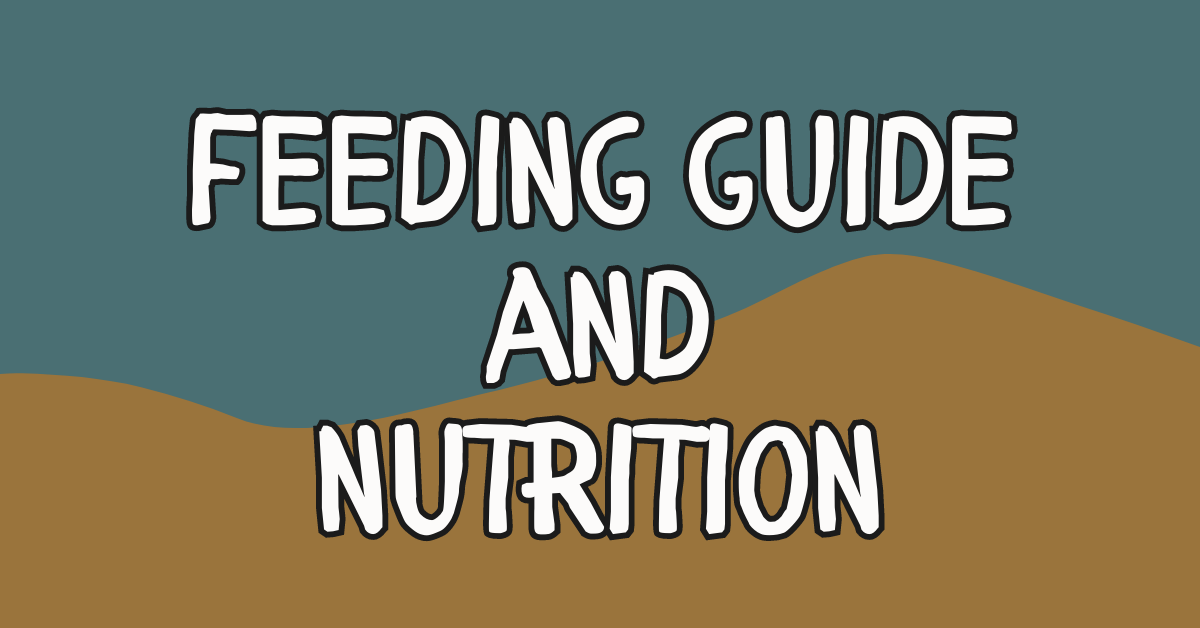Nutritional Requirements and Expert Advice
Providing a balanced and varied diet is essential for your bearded dragon’s health and well-being. This section offers an in-depth guide to understanding and fulfilling their nutritional requirements at different life stages.
Table of contents
Nutritional Composition
Bearded dragons are omnivorous, requiring a mix of animal and plant-based foods. The ideal diet varies based on their age:
- Hatchlings and juveniles (0-12 months): 70% insects, 30% vegetables and greens, with a small portion of fruits.
- Sub-adults (12-18 months): 50% insects, 50% vegetables and greens, with a small portion of fruits.
- Adults (18 months and older): 20-30% insects, 70-80% vegetables and greens, with a small portion of fruits.
Video: Safe Foods
Related Article: Bearded Dragon Care: Expert Tips and Insights
Insects
Offer a variety of high-quality, gut-loaded insects to your bearded dragon. These insects should be appropriately-sized, typically no larger than the space between your bearded dragon’s eyes. Suitable options include:
- Crickets: A staple insect that can be easily purchased or bred.
- Dubia roaches: Nutrient-rich and less likely to cause impaction compared to mealworms or superworms.
- Black soldier fly larvae (Phoenix worms): High in calcium and a good alternative to crickets and roaches.
- Hornworms and silkworms: Nutritious and can be offered as an occasional treat.
- Mealworms and superworms: Use sparingly, as they have a high chitin content that can lead to impaction.
Dust insects with calcium powder (with or without vitamin D3, depending on your UVB setup) every other feeding for juveniles and twice a week for adults. Additionally, dust insects with a multivitamin supplement once a week for juveniles and twice a month for adults.

Crickets and dubia roaches are the most common and readily available insects, while the others may require more effort to find.
It’s important to offer a varied diet of different insects to ensure your bearded dragon receives a range of nutrients.
Feeding Schedule and Portion Sizes
The feeding schedule and portion sizes for insects should be adapted based on your bearded dragon’s age and activity level. Hatchlings and juveniles should be offered insects 2-3 times a day and vegetables daily. Sub-adults should be offered insects once a day and vegetables daily. Adults should be offered insects 3-4 times per week and vegetables daily.
The appropriate portion size depends on the size of your bearded dragon and the type of insect. As a general rule, the portion size should be no larger than the space between your bearded dragon’s eyes.
Gut-Loading and Supplementation
Gut-loading is the process of feeding the insects a nutritious diet before feeding them to your bearded dragon. This ensures that your bearded dragon receives a varied and nutritious diet from their insects. Suitable foods for gut-loading include dark leafy greens, carrots, and sweet potatoes.
Supplementation is also important to ensure your bearded dragon receives all the necessary nutrients. A calcium supplement should be dusted on the insects before feeding them to your bearded dragon. A multivitamin supplement can be added once or twice a week.
Insects to Avoid
There are some insects that should be avoided when feeding your bearded dragon, including:
- Fireflies
- Lightning bugs
- Ladybugs
- Mealworms (in large amounts)
These insects can be toxic or harmful to bearded dragons and should be avoided.
Offering a varied and balanced diet of suitable insects is an essential part of a bearded dragon’s diet. Ensure your bearded dragon receives the appropriate portion size, gut-loading, and supplementation.
Avoid feeding toxic or harmful insects to your bearded dragon.
Vegetables and Greens
Offering a variety of vegetables and greens is an essential part of a bearded dragon’s diet. Here is a list of suitable options and important considerations to keep in mind when feeding your bearded dragon vegetables and greens.

Suitable Vegetables
Suitable vegetables for bearded dragons include:
- Collard greens
- Mustard greens
- Turnip greens
- Dandelion greens
- Kale (in moderation)
- Spinach (in moderation)
- Butternut squash
- Zucchini
- Green beans
- Carrots
Vegetables should be chopped into small pieces and offered raw or lightly steamed. Avoid offering canned vegetables, as they are high in sodium and preservatives.
Suitable Greens
Suitable greens for bearded dragons include:
- Endive
- Escarole
- Romaine lettuce
- Red and green leaf lettuce
- Arugula
- Watercress
- Chicory
Greens should be offered in small amounts and rotated regularly to ensure a varied diet.
Important Considerations
When offering vegetables and greens, it’s important to consider their calcium to phosphorus ratio. Bearded dragons require a diet that has more calcium than phosphorus to prevent metabolic bone disease. Suitable vegetables and greens for bearded dragons have a calcium to phosphorus ratio of at least 2:1.
It’s also important to offer a variety of vegetables and greens to ensure a balanced and varied diet. Feeding the same vegetables or greens every day can lead to a nutrient deficiency or toxicity.
Foods to Avoid
There are some foods that should be avoided when feeding your bearded dragon vegetables and greens, including:
- Avocado
- Rhubarb
- Beet greens
- Swiss chard
- Spinach (in large amounts)
- Cabbage (sparingly)
- Iceberg lettuce
These foods can be harmful or toxic to bearded dragons and should be avoided.
In summary, providing a variety of vegetables and greens is an essential part of a bearded dragon’s diet. Offer a variety of suitable options with a calcium to phosphorus ratio of at least 2:1, and avoid feeding toxic or harmful foods.
Regularly rotate the types of vegetables and greens to ensure a balanced and varied diet.
Fruits
Fruits should be fed sparingly, as they are high in sugar and can cause digestive upset if offered too frequently. Suitable options include:
- Berries: Blueberries, strawberries, raspberries, and blackberries.
- Tropical fruits: Mango, papaya, and kiwi.
- Other fruits: Apple, pear, tomato, and peach.
Avoid citrus fruits, as they can cause digestive upset and harm the calcium-to-phosphorus ratio in your bearded dragon’s diet.
Fruits can be a healthy addition to a bearded dragon’s diet, providing essential vitamins and nutrients. However, they should be fed sparingly as they are high in sugar. Here is a overview of some suitable fruits for bearded dragons and important considerations when feeding them.
Suitable Fruits
Suitable fruits for bearded dragons include:
- Apples (without seeds)
- Blueberries
- Cantaloupe
- Grapes (seedless)
- Mango
- Papaya
- Banana
- Strawberries
- Watermelon (without seeds)
Fruits should be chopped into small pieces and offered in moderation as a treat, alongside a balanced diet of vegetables and insects.

Important Considerations
When feeding fruits to your bearded dragon, it’s important to remember that they should not make up a significant portion of their diet. Fruits are high in sugar and should be fed sparingly, as excessive sugar intake can lead to obesity and other health problems.
It’s also important to remove any seeds or pits from the fruit before offering it to your bearded dragon. These can be a choking hazard or cause digestive issues.
Fruits to Avoid
There are some fruits that should be avoided when feeding your bearded dragon, including:
- Citrus fruits (such as oranges and lemons)
- Grapes (with seeds)
- Avocado
- Rhubarb
- Tomato
- Peach
- Plum
These fruits can be harmful or toxic to bearded dragons and should be avoided.
While fruits can be a healthy addition to your bearded dragon’s diet, they should be fed sparingly and in moderation. Choose suitable fruits without seeds or pits, and avoid feeding toxic or harmful fruits to your bearded dragon.
A varied and balanced diet of vegetables and insects should remain the mainstay of your bearded dragon’s diet.
Feeding Schedule and Portion Sizes
Adapt the feeding schedule and portion sizes based on your bearded dragon’s age and activity level:
- Hatchlings and juveniles: Offer insects 2-3 times a day and vegetables daily. Allow 10-15 minutes of feeding for insects before removing any uneaten ones.
- Sub-adults: Offer insects once a day and vegetables daily. Allow 10-15 minutes of feeding for insects before removing any uneaten ones.
- Adults: Offer insects 3-4 times per week and vegetables daily. Provide a portion size that your bearded dragon can comfortably consume within 10-15 minutes for insects and offer a generous amount of vegetables.
Always remove uneaten food from the enclosure to maintain cleanliness and prevent spoilage.
Water and Hydration
Bearded dragons obtain most of their hydration from their food, but providing a shallow water dish can help ensure they stay adequately hydrated. The water dish should be large enough for the bearded dragon to submerge its body but shallow enough to prevent drowning. Replace the water daily and clean the dish regularly.
You can also offer hydration through occasional misting or by providing water-rich vegetables like cucumber. However, be cautious not to over-mist the enclosure, as excessive humidity can lead to respiratory infections.
By understanding your bearded dragon’s nutritional requirements and providing a varied and balanced diet, you can support their overall health, growth, and well-being. Regular monitoring and adjustments to their diet based on age, size, and activity level will ensure your bearded dragon thrives throughout their life.
Conclusion and final thoughts 💭
Feeding and diet are crucial aspects of a bearded dragon’s care, and providing a balanced and varied diet is essential for their health and wellbeing. Offering a variety of vegetables and greens, insects, and fruits in moderation can help ensure that your bearded dragon receives all the necessary nutrients they need.
It’s important to remember that different age groups of bearded dragons require different feeding schedules and portion sizes. Proper gut-loading and supplementation can also help ensure that your bearded dragon receives all the necessary nutrients from their food.
Avoid feeding your bearded dragon toxic or harmful foods, and always provide a varied and balanced diet to prevent nutrient deficiencies or toxicities.
By following these guidelines and offering a balanced and varied diet, you can help ensure that your bearded dragon maintains a healthy weight, good digestion, and overall good health throughout their life.
Frequently Asked Questions: Feeding and Diet
What should be the main component of a bearded dragon’s diet?
A bearded dragon’s diet should consist of a variety of vegetables and greens, insects, and sparingly, fruits.
What are suitable vegetables and greens for bearded dragons?
Suitable vegetables and greens for bearded dragons include collard greens, mustard greens, turnip greens, dandelion greens, kale (in moderation), spinach (in moderation), butternut squash, zucchini, green beans, and carrots. Suitable greens include endive, escarole, romaine lettuce, red and green leaf lettuce, arugula, watercress, and chicory.
What insects are suitable for bearded dragons?
Suitable insects for bearded dragons include crickets, dubia roaches, black soldier fly larvae, hornworms, and silkworms.
How often should I feed my bearded dragon vegetables and insects?
The feeding schedule for vegetables and insects depends on the age and activity level of your bearded dragon. Hatchlings and juveniles should be offered insects 2-3 times a day and vegetables daily. Sub-adults should be offered insects once a day and vegetables daily. Adults should be offered insects 3-4 times per week and vegetables daily.
How much should I feed my bearded dragon?
The appropriate portion size depends on the size of your bearded dragon and the type of food. As a general rule, the portion size should be no larger than the space between your bearded dragon’s eyes.
What is gut-loading?
Gut-loading is the process of feeding insects a nutritious diet before feeding them to your bearded dragon. This ensures that your bearded dragon receives a varied and nutritious diet from their insects.
What supplements should I add to my bearded dragon’s diet?
Calcium supplements should be dusted on the insects before feeding them to your bearded dragon. A multivitamin supplement can be added once or twice a week.
What fruits can I feed my bearded dragon?
Suitable fruits for bearded dragons include apples (without seeds), blueberries, cantaloupe, grapes (seedless), mango, papaya, strawberries, and watermelon (without seeds). Fruits should be fed sparingly and in moderation.
What foods should I avoid feeding my bearded dragon?
Foods to avoid feeding your bearded dragon include citrus fruits, grapes (with seeds), avocado, rhubarb, tomato, peach, plum, fireflies, lightning bugs, ladybugs, and mealworms (in large amounts).
How do I ensure a balanced and varied diet for my bearded dragon?
Offering a variety of suitable vegetables and greens, insects, and fruits in moderation can help ensure a balanced and varied diet for your bearded dragon. Gut-loading and supplementation are also important considerations.
What are the signs of a nutrient deficiency in bearded dragons?
Signs of a nutrient deficiency in bearded dragons can include lethargy, lack of appetite, muscle weakness, stunted growth, and metabolic bone disease. Regular veterinary care can help prevent and address nutrient deficiencies.





Leave a Reply